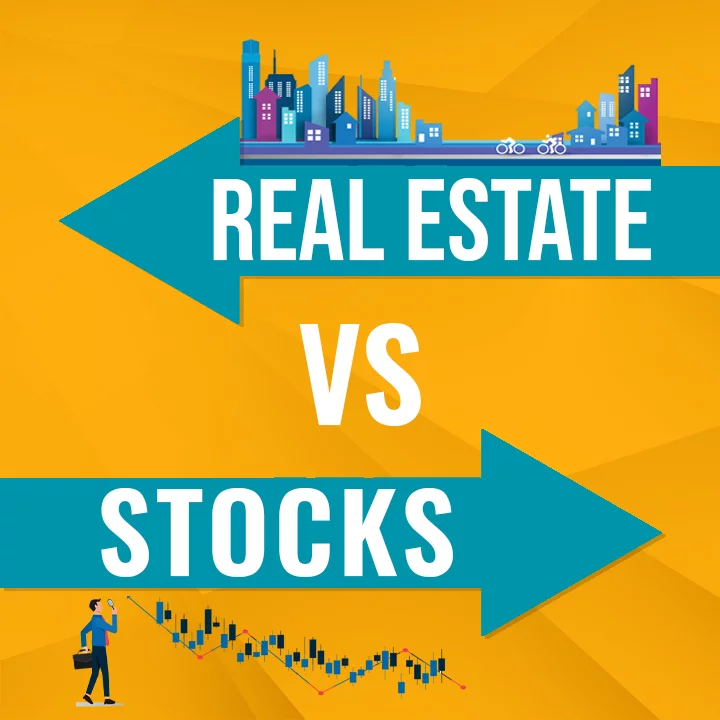Table of contents
ToggleIntroduction
Over the past 30 years, the S&P 500 has delivered an average annual return of about 10%. During the same period, real estate prices in many major markets have more than tripled. Both asset classes have proven their ability to generate wealth—but in very different ways.
For investors looking to build long-term financial security, the question isn’t just “Which one performs better?” but rather “Which one is better suited to my goals, risk tolerance, and strategy?”
In this article, we’ll explore the fundamental differences between real estate and stock market investing, compare their performance and risk profiles, and help you determine which may be the smarter choice for your long-term portfolio—or whether a blend of both offers the best path to financial success.
1. Understanding the Investment Vehicles
Before comparing real estate and stocks in terms of returns, risk, and long-term strategy, it’s essential to understand the nature of each investment vehicle. Real estate and stocks offer very different structures, income sources, and levels of involvement—and these differences shape the entire investment experience.
A. Real Estate: Tangible Assets with Income Potential
Real estate investing involves purchasing physical property with the goal of generating income or capital gains. This can include residential homes, rental apartments, commercial buildings, or even raw land. Investors often rely on two main sources of return:
Rental income, which provides regular cash flow.
Capital appreciation, when the property increases in value over time.
Real estate can also benefit from leverage — borrowing money to buy a property with only a fraction of its value (e.g., a mortgage), which can amplify returns (and risks). However, real estate demands high initial capital, comes with significant transaction and maintenance costs, and is not liquid — selling can take weeks or months.
Despite these challenges, real estate is appealing for those who value control, tangible assets, and steady income over time.
B. Stocks: Scalable, Liquid, and Accessible
Stock market investing means buying shares in publicly traded companies. As a shareholder, you benefit from:
-
Capital gains, when share prices rise.
-
Dividends, regular distributions of company profits.
Stocks are highly liquid, easy to buy or sell at any time, and accessible to all investors, thanks to low-cost online platforms and the ability to start with small amounts (even a few euros or dollars). Investors can build diversified portfolios with ETFs or mutual funds, gaining exposure to entire markets, sectors, or geographies with a single click.
Stocks require less day-to-day involvement than real estate, but they do involve more short-term volatility. Price swings are common, especially in reaction to economic or political events. Successful stock investing demands emotional discipline and a long-term mindset.
C. Risk & Return Fundamentals
Both real estate and stocks offer opportunities for long-term wealth creation, but their risk-return dynamics are distinct.
Historically, the U.S. stock market has returned about 7–10% annually after inflation. Real estate, depending on the market and leverage used, typically returns between 4–8% per year after costs.
However, real estate can outperform in certain locations or with savvy management and leverage. The key difference lies in how consistent and scalable these returns are.
- Stocks are more volatile in the short term. Prices can swing wildly in response to earnings reports, interest rates, and macroeconomic news. However, the long-term trend has generally been upward.
- Real estate is less volatile day-to-day but can suffer during housing crises, as seen in 2008. Moreover, real estate is often tied to local economic and demographic trends.
Each asset class reacts differently to economic cycles: for example, rising interest rates may depress stock valuations and simultaneously increase mortgage costs, hurting property demand.
Real estate is often seen as a natural hedge against inflation, since property values and rents tend to rise with the cost of living. Stocks, on the other hand, can also be good inflation hedges if the companies can pass rising costs to consumers, thereby maintaining profit margins.
In summary, real estate and stocks are fundamentally different investment vehicles, each with unique characteristics. Real estate offers stability, cash flow, and tangibility—but requires active management and large capital. Stocks offer accessibility, liquidity, and scalability—but demand emotional resilience during volatile markets.
2. Comparative Analysis: Real Estate vs. Stocks
Now that we’ve explored the fundamentals of each investment vehicle, it’s time to compare them head-to-head across the dimensions that matter most to long-term investors: performance, risk, costs, and diversification. This section will provide a clearer picture of which asset class may better suit different types of investors, and why.
A. Performance Over Time
When comparing long-term returns, stocks have historically outperformed real estate on average — but the full picture is more complex.
Over the last century, the U.S. stock market (measured by indices like the S&P 500) has delivered an average annual return of about 10% before inflation (roughly 7% after inflation), assuming dividends are reinvested. That kind of compounding growth, especially when held over decades, is what makes stock investing so powerful.
Real estate, meanwhile, has produced average returns between 4% and 8%, depending on the type of property, location, and management strategy. However, these numbers can increase significantly when leverage is used. For example, a 5% increase in property value on a home bought with 20% down can result in a 25% return on the invested equity.
It’s also worth noting that real estate generates passive income through rent, which can be reinvested or used as regular cash flow. Stocks can also provide income, through dividends, although many growth stocks reinvest profits rather than pay them out.
Lastly, performance also depends on local vs. global exposure. Stock investors can access the global economy with a diversified ETF, while real estate returns are often tied to local market conditions and may vary drastically between cities or regions.
B. Risk and Volatility
Risk is one of the most important differentiators between these two asset classes — not just in terms of returns, but in how those returns are delivered and experienced over time.
Stocks are inherently more volatile, with prices reacting instantly to earnings reports, political events, interest rate decisions, or global crises. A diversified portfolio can drop 20–30% in a matter of weeks, as seen during the COVID-19 crash in March 2020. However, long-term investors who stay invested through downturns have historically recovered and achieved strong gains.
Real estate appears more stable, in part because properties are not priced daily. However, this perceived stability can be misleading. Property values can fall significantly in recessions, as seen during the 2008 housing crisis, and investors can face vacancies, tenant issues, or costly repairs. Moreover, if mortgage rates rise, monthly costs can increase or property values may decline due to reduced affordability.
Another key factor is diversification:
In stocks, diversifying across sectors, industries, and geographies is easy and affordable with index funds and ETFs.
In real estate, diversification is more difficult. Owning multiple properties requires substantial capital and management effort. A portfolio heavily exposed to one geographic area is vulnerable to regional downturns.
Real estate also involves operational risk — the risk that something goes wrong with the property, tenants, or local market. Stocks don’t require such management and are purely financial instruments, making them more passive — but potentially more emotionally stressful due to price volatility.
C. Costs, Taxes, and Accessibility
A thorough comparison of any investment must include an honest look at the real costs — not just what you pay upfront, but the ongoing expenses, tax impacts, and ability to access your money.
Real estate is expensive to enter and maintain. It typically requires:
-
A large down payment (usually 10–25% of the purchase price)
-
Closing costs, inspection fees, and agent commissions
-
Recurring costs: property taxes, insurance, maintenance, and sometimes homeowners’ association (HOA) fees
In addition, selling a property can take weeks or months, and transaction costs can eat up 6–10% of the property’s value. Real estate is illiquid — you can’t easily sell off a room of your house to free up cash in an emergency.
Stocks, by contrast, are low-cost and highly liquid. You can invest with a few dollars via fractional shares, and trading is often commission-free. ETFs have extremely low expense ratios (as low as 0.03%), and there are no ongoing maintenance costs. Liquidity is a major advantage — you can buy or sell shares in seconds.
On the tax front, both investments offer benefits:
-
Real estate investors can use depreciation, mortgage interest deductions, and 1031 exchanges (in the U.S.) to defer taxes.
-
Stock investors pay capital gains tax when they sell, and long-term gains are usually taxed at lower rates. Qualified dividends may also be taxed favorably.
However, real estate tax filing is more complex, especially for rental properties or multi-property portfolios. Stock investing, particularly through tax-efficient ETFs, is simpler to manage and track.
In summary, stocks offer superior liquidity, lower costs, and higher average returns, especially for investors seeking a passive, scalable approach. Real estate offers stable cash flow, leverage opportunities, and a physical asset base, making it attractive to those who prefer tangible investments and are willing to manage the operational aspects.
In the next section, we’ll examine how these differences align with different investor profiles, and how real-world conditions — like interest rates and economic cycles — can influence your decision.
3. Strategic Considerations for Investors
The decision between real estate and stocks goes beyond return percentages and risk metrics. It ultimately comes down to strategy — specifically, how each investment aligns with your personal goals, lifestyle, and the broader economic environment. In this final section, we explore three key considerations that should guide your long-term investment choices.
A. Aligning with Your Investor Profile
One of the most important strategic steps is assessing who you are as an investor. This includes your financial goals, your risk tolerance, your available time, and even your personality.
If you prefer hands-off investing and value simplicity, the stock market offers a low-maintenance path to growth. With automated contributions, index funds, and dividend reinvestment plans, it’s possible to build wealth consistently without active involvement.
In contrast, real estate requires a more active and entrepreneurial mindset. Managing properties, dealing with tenants, and navigating financing and maintenance are part of the process. While property management services can reduce the workload, real estate is rarely 100% passive.
Your age and life stage also play a role. Younger investors may lean toward stocks to maximize compounding over decades, while older investors may seek real estate for its income potential and perceived stability. That said, there’s no strict rule — many successful investors balance both throughout their lives.
Finally, your financial capacity matters. Stocks are accessible at any level — you can begin with just a few dollars. Real estate, on the other hand, requires substantial capital and the ability to take on debt. If your resources are limited, stocks may be the more practical starting point.
B. Responding to Economic and Market Conditions
Even the best investment plan must adapt to the economic environment. Understanding the impact of interest rates, inflation, and market cycles is essential when choosing between real estate and stocks — or balancing both.
When interest rates are low, borrowing to buy property becomes more attractive. Monthly mortgage payments are reduced, and leverage can amplify returns. This often leads to rising real estate prices, especially in high-demand areas.
Conversely, when interest rates rise, mortgage costs increase and housing affordability drops, potentially cooling real estate markets. At the same time, rising rates can compress stock valuations, especially for growth stocks that depend on future earnings.
Inflation also plays a key role. Real estate tends to perform well in inflationary periods, as property values and rents rise with the cost of living. Stocks, too, can act as an inflation hedge if companies can pass higher costs on to consumers — though certain sectors perform better than others in this environment (e.g., energy, consumer staples).
Lastly, consider recession resilience. During downturns, stocks tend to fall quickly but also recover fast. Real estate, especially rental properties, can provide stable income through the cycle — but vacancies may rise and financing may become harder to obtain.
A wise investor pays attention not only to personal circumstances but also to macroeconomic shifts, adjusting their exposure accordingly.
C. Combining Both in a Diversified Strategy
Rather than viewing real estate and stocks as opposing choices, many experienced investors choose to combine both in a balanced portfolio. This approach allows you to capture the benefits of each while mitigating their respective weaknesses.
For example:
Stocks offer liquidity, scalability, and global diversification. They provide growth and compounding through reinvested earnings.
Real estate offers stability, inflation protection, and cash flow through rental income. It also brings portfolio diversification, as real estate values do not always move in tandem with stock prices.
A common strategy is to start with stocks — especially for younger investors with limited capital — and gradually add real estate exposure over time, either through direct property investment or REITs. REITs allow investors to benefit from real estate income without owning or managing physical properties. They also offer liquidity and are traded on public exchanges, making them ideal for hybrid strategies.
You can also allocate your portfolio intentionally, for example:
70% stocks, 20% real estate, 10% cash or bonds for growth-focused investors
50% stocks, 30% real estate, 20% fixed income for more conservative investors
This blended approach not only improves risk-adjusted returns, but also provides multiple income sources, hedging against both market volatility and inflation.
Conclusion
Both real estate and stocks have consistently proven their ability to generate long-term wealth. But they do so in fundamentally different ways.
- Stocks offer ease of access, high liquidity, and powerful compounding potential through reinvested dividends and long-term market growth. They’re ideal for investors seeking a passive, scalable, and globally diversified approach.
- Real estate, on the other hand, provides tangible assets, steady cash flow, and the opportunity to use leverage to amplify returns. It suits those who value control over their investments and are comfortable with a more hands-on approach.
Ultimately, the “better” investment is the one that aligns with your financial goals, risk tolerance, time horizon, and personal preferences. For many investors, the smartest move isn’t choosing between the two—but rather, building a balanced portfolio that combines both, creating a resilient and diversified foundation for long-term success.
Before investing, ask yourself:
Do I want passive growth or active income? Am I prepared to handle property management, or would I rather automate my investments? How do I respond to market volatility or liquidity constraints?
Answering these questions honestly will guide you toward the strategy that’s right for you—because in personal finance, the best investment is the one you can stick with over time.





